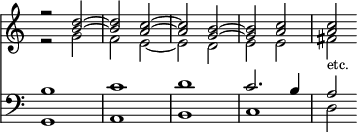is simply an elaboration of the progression:—

In fact, Palestrina's success in the attempt to revivify Church Music lay chiefly in the recognition of harmonic principles; and in many cases this recognition amounts to the use of simple successions of chords in note against note counterpoint, as a contrast to the portion of the work which is polyphonic. His success also depended to a great degree on a very highly developed sense for qualities of tone in chords arising from the distribution of the notes of which they are composed. He uses discords more frequently than his predecessors, but still with far greater reticence than a modern would do; and in order to obtain the necessary effects of contrast, he uses chords in various positions, such as give a variety of qualities of softness or roughness. This question, which shows to what a high degree of perfection the art was carried, is unfortunately too complicated to be discussed here, and the reader must be referred to part ii. chap. 12 of Helmholtz's work on the 'Sensations of Tone as a physiological basis for the theory of Music,' where it is completely investigated. As an example of the freedom with which accidentals were used in secular music in Palestrina's time may be taken the following passage from a madrigal by Cipriano Bore, which is quoted by Burney (Hist. iii. 319):—

It will have been remarked from the above survey, that from the dawn of any ideas of combination of notes, musicians were constantly accepting fresh facts of harmony. First perfect consonances, then imperfect, and then suspended discords, which amounted to the delaying of one note in passing from one concord to another; then modifications of the scales were made by the use of accidentals, and approaches were by that means made towards a scale which should admit of much more complex harmonic combinations. But before it could be further modified, it was necessary that a new standpoint should be gained. The great musicians of the 16th century had carried the art to as high a pitch of perfection in the pure polyphonic style as seems to us possible, and men being accustomed to hear in their works the chords which were the result of their polyphony were ready for the first steps of transition from that style to the harmonic. Palestrina, the hero of the old order, died in 1592, and in 1600 the first modern opera, the 'Euridice' of Giacomo Peri, was performed at Florence. It is impossible to point definitely to any particular time and say 'Here the old order ended and the new began,' for in point of fact the periods overlap one another. A species of theatrical performance accompanied by music had been attempted long before this, and secular music had long displayed very free use of chromaticisms similar to the modern style of writing; and, on the other hand, fine examples of polyphony may be found later; but nevertheless the appearance of this opera is a very good typical landmark, since features of the modern school are so clearly displayed in it, such as arias and recitatives accompanied harmonically after the modern manner; moreover in these the harmonies are indicated by figures, which is a matter of considerable importance, as it implies a total change of position relative to the construction of the music. As long as harmony was the accidental result of the combination of different melodies, the idea of using abbreviations for a factor which was hardly a recognized part of the effect would not have occurred to any one, but as soon as harmony came to be recognized as a prominent fact, the use of signs to indicate the grouping of notes into these chords would naturally suggest itself, especially as in the infancy of these views the chords were of a simple description. That the system of figuring a bass was afterwards largely employed in works founded exclusively on the old theory of counterpoint is no argument against this view, as no one can fail to see how entirely inadequate the figuring is to supply any idea whatever of the effects of contrapuntal music. With Peri are associated the names of Cavaliere, Viadana, Caccini, and Monteverde. To Caccini the invention of recitative is attributed, to Viadana that of the 'basso continuo,' and to Monteverde the boldest new experiments in harmony; and to the present question the last of these is the most important. It has already been remarked that during the previous century progress had been rather in technical expression and perfection of detail than in new harmonies. Palestrina's fame does not rest upon elaborate discords, but upon perfect management of a limited number of different combinations. Monteverde evidently abandoned this ideal refinement, and sought for harsher and more violent forms of contrast. Thus in a madrigal 'Straccia me pur,' quoted in Burney's History (iii. 239), the following double suspensions occur:—

But a far more important innovation, which there need be no hesitation in attributing to him, as he was personally blamed for it by the dogmatists of his time, was the use of the minor seventh, which we call the Dominant seventh, without preparation. There is more than one example
